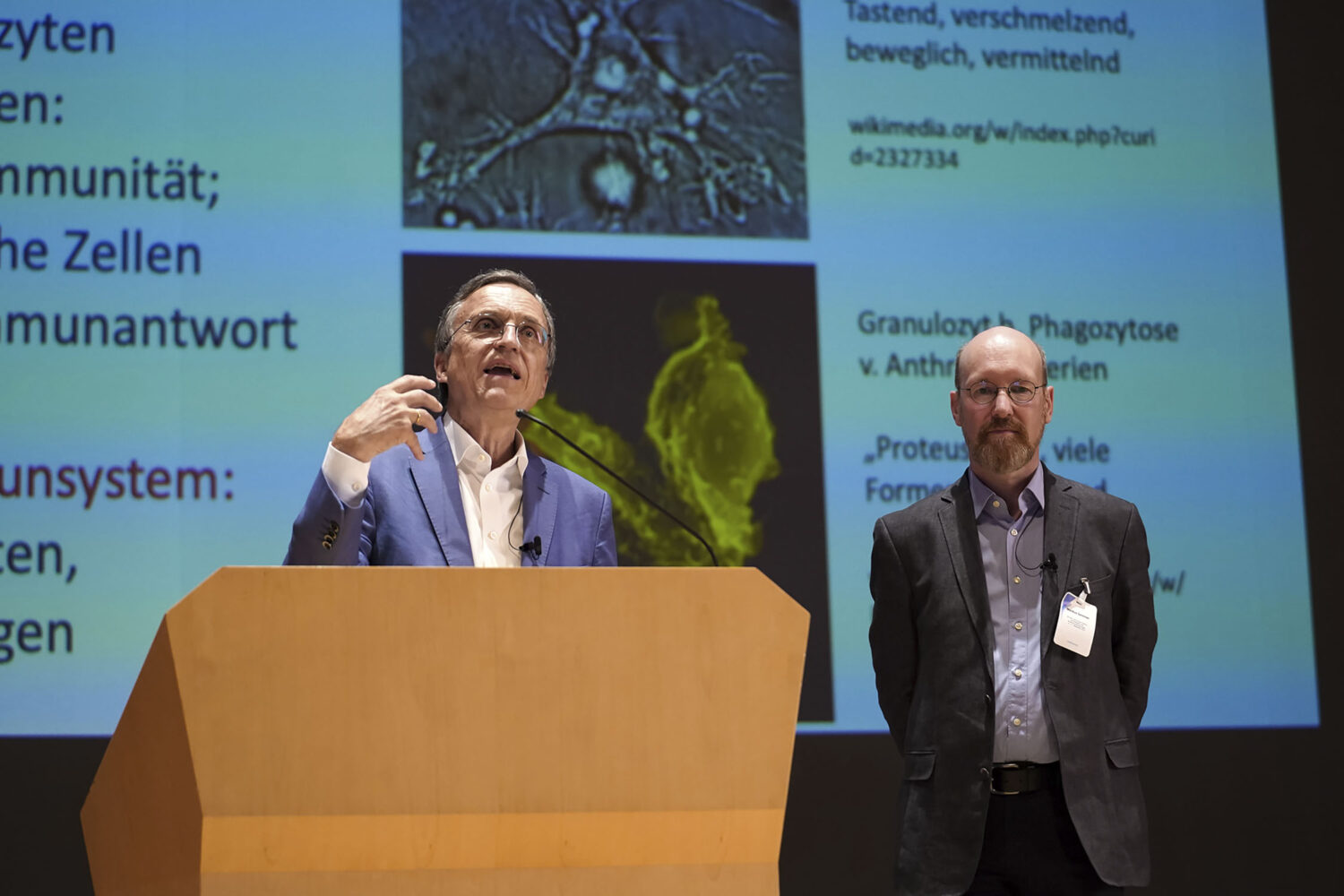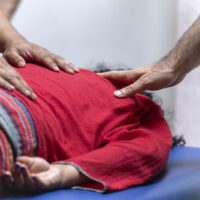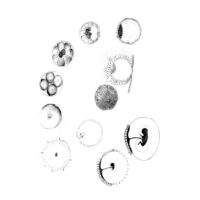Markus Sommer and Georg Soldner spoke, in alternating dialogue, about the human immune system. Forty years ago, when they were both students, this field of research was still relatively straightforward. Today, new receptors are constantly being discovered, and the immune system is revealing itself to be a network of reciprocal perception. At the same time, anthroposophical knowledge of the human being is making the causes of autoimmune diseases comprehensible.
Markus Sommer outlined a threefold division of labour in the immune cells that occur as white blood cells in the blood and are found in the tissues of the organism. First, there are macrophages, which means “large eaters,” that ingest “invaders”—cells with enzymes that can generate heat and release oxygen radicals in order to burn anything that would endanger the organism. Then there are dendritic cells with fine projections that sense foreign substances, for example, in the mucous membranes of the oral cavity, and offer other cells these foreign substances to be first absorbed and then processed, for perception. These cells can trigger and strengthen immune reactions—one dendritic cell can activate up to 3,000 lymphocytes—but they can also have an anti-inflammatory and thus regulatory effect. Finally, there are lymphocytes that morphologically have a large nucleus, among which memory cells can survive for years. The “sulphuric” cells, characterised by warmth, the mediating “mercurial” dendritic cells, and the “salt-like” cells that exhibit a long-term “neuro-sensory-like” memory function, reveal a clear threefold structure.
The Organ of the Middle
Georg Soldner added that the thymus, a central organ of the immune system, is located between the heart and lungs. The thymus develops from all three embryonic germ layers: the embryonic ectoderm, which demarcates the outside and forms the skin and nervous system; the entoderm, from which the intestinal mucosa and central metabolic organs such as the liver and pancreas form; and the mesoderm, which gives rise to the circulatory system and skeleton, among other things. The thymus thus represents the whole person. This distinguishes it from other organs that form from one or a combination of two germ layers.
According to Soldner, we can look into the “innermost part of the I-organisation” when we look at the “school” through which the T-cells in the thymus cortex migrate. Here, the parental genetic material is split so that the T lymphocytes—the cells that are “trained” in the thymus—learn to form increasingly differentiated sensory organs, so-called receptors, in order to be able to distinguish between their own and foreign proteins. According to current estimates, ten quadrillion (10 to the power of 16) different surface features could be distinguished. There is a substance here, the “autoimmune regulator”, which is like a homunculus in the thymus, in which all human proteins are formed, from the insulin of the pancreas to the proteins of the muscles. If one of the T lymphocytes formed by the process described above reacts to this image of the body’s entire protein world, this cell is not allowed to leave the thymus and is killed in order to prevent autoimmune reactions. “Only when the lymphocytes have proven their ability to distinguish between their own and foreign substances do they leave the thymus at the cortical border and migrate into the peripheral lymphatic organs.” Soldner described how the thymus develops in the first three years of life, in parallel with walking, speaking and thinking and the development of intestinal flora, and culminates in size at puberty. Then the organ involutes, and around the age of 40 to 50, we can no longer produce new T lymphocytes. Interesting fact: this is how long primates and humans who live in nature, live to be without cultural assistance.
It used to be thought that the thymus no longer played a role in adults, but new studies on patients who have had their thymus removed during heart surgery show that the mortality rate of these patients triples after five years, and autoimmune diseases increase by fifty percent. The thymus, Soldner said, belongs to the generative side of the I, its night side, and also plays a role in adulthood. At 110 or 120 years of age, this central organ of the I-organisation is then completely used up, so the thymus cortex is something like a clock for the maximum lifespan.
Markus Sommer added that the drug cortisone accelerates the ageing process of the thymus, as do long-term increases in cortisol concentrations, which can occur, for example, in the case of prolonged stress or depression or with medication. Sex hormones also increase the breakdown of the thymus, which calls into question the widespread tendency to administer them in geriatric medicine.
The Pulse of the Spleen
Sommer then turned to the spleen, the second immune system organ, which is home to a quarter of all immunologically active cells. Here, the blood is purified and tested. Extension and curvature, the basic architectural forms, are revealed as the basic structure of the vascular system of the spleen. This is where the dendritic mercurial immune cells meet the T cells and find out “what is going on in the organism.” The spleen also produces B lymphocytes, which migrate into the intestinal wall to protect the body from too direct contact between food, bacteria, and the intestinal wall by producing protective substances known as immunoglobulins (IgA), which line the intestinal wall. With gluten intolerance (celiac disease), this barrier and the spleen function are weakened.
Therapeutically, it was often important to strengthen spleen activity. This organ is connected to the brain via the vagus nerve, which has a special relationship with the brain region involved in stress processing. That is why, Sommer said, it is not surprising that, as experiments have shown, the spleen changes under prolonged stress. A research group led by Johannes Weinzirl showed that the spleen changes size depending on food intake and independently displays a pulse every minute—a rhythm that is then lost during illness. Rudolf Steiner had pointed out the regulatory function of the spleen, and these observations provide aspects of this.
Georg Soldner then presented two anthroposophical medicines that have a fundamentally beneficial effect on the immune system. The first, Thymus (D7) / Mercurius (D14), not only boosted the immune system but also helped to limit inflammation. The second, Lien compositum, was developed by Heinz Hartmut Vogel, co-founder of Wala. It contained potentised organ preparations of the spleen, kidneys and connective tissue. Soldner gave it to children suffering from cancer whose immune system had been severely weakened by chemotherapy. This reduced susceptibility to infections. Lien compositum could also help if the immune system is weakened by vaccination. In children and adults susceptible to infections, “dramatic improvements in immunity can be achieved in some cases,” according to Soldner.

The Phenomenon of Multiple Sclerosis
Markus Sommer went on to speak about the autoimmune disease multiple sclerosis. Inflammation and sclerosis of the nerves are interdependent, with patients initially suffering from inflammatory attacks—the more favourable form of the disease in terms of prognosis—while a gradual sclerotic variant often develops as the disease progresses. These two poles in the course of the disease—one with an inflammatory emphasis and one sclerosing—exist in several autoimmune diseases.
Sommer then showed studies on the geographical distribution of MS and pointed out that Rudolf Steiner had called for the development of a “geographical medicine”. This shows that inhabitants of very northern and southern latitudes are much more affected by multiple sclerosis than people in the equatorial region, where the disease is almost unknown. What counts most is where a person grew up for the first 14 years of their life. The sun must, therefore, play a role here. It also emerged that people with MS played less outdoors in childhood.
Sommer explained that heavy use of sunscreens contributed to a higher probability of MS. He cited a study according to which the risk of MS for children in their second seven-year period is reduced by 70 percent if they are exposed to the sun for at least 2–3 hours at weekends and during holidays. “If a medicine could do that, everyone would have to take it!” According to a study, it is particularly important to be outdoors in winter, even though the low sun means that the UV-B required for vitamin D production no longer reaches the ground. This suggested that, given the proven effect of sunlight, there was more at play than just this vitamin.
He cautioned that there were diseases for which sun exposure is not as beneficial, such as lupus erythematosus. Rudolf Steiner gave an MS patient a meditation for the morning, midday, and evening. This showed that the health-giving effect of the sun is also about inner light. The morning meditation ends with the visualisation of being surrounded by a glowing orange, warming sky. Many patients also described feelings of disconnection, alienation and withdrawal from the world. This is where Rudolf Steiner’s midday meditation could help:
God’s wisdom brings order to the world.
It also brings order to me.
I want to live in it.
God’s love brings warmth to the world.
It also brings warmth to my heart.
I want to breathe in it.
God’s strength carries the world.
It also carries my body.
I want to think in it.
Our relationship with the world changes when we immerse ourselves in these lines. And for the evening:
It will be dark.
My soul goes into the darkness.
It will shine in the darkness.
Shine because wisdom, strength
and the goodness of the Godhead within it.
Wisdom, strength and goodness
grow in the dark.
Through them, my soul wants
to radiate again, full of life,
through head, heart and limbs.
In this meditation, we experience that with the soul, which comes out of the night, we carry light qualities down into the body with which we reconnect, letting them become effective with our actions in the world. This can create a new relationship with our body, which threatens to become alien in autoimmune disease.
The Mother-in-Law Should Stay Outside
Lastly, Georg Soldner described the specific case of a patient he treated together with a Taiwanese doctor. A 48-year-old teacher with symptoms of hyperthyroidism suffered from hand tremors, palpitations, sweating, bulging eyes and sleep disorders. Antibodies in the blood showed that her immune system was reacting to the thyroid tissue, attacking it and releasing an excess of thyroid hormones. The slim, active patient only realised the extent of her exhaustion during treatment. Like many patients with autoimmune diseases, she was strong on the level of her I, a responsible person with presence at the daytime level. Biographically, she also showed a pattern that, in the experience of both speakers, was found in many patients with autoimmune thyroid diseases—the most common autoimmune diseases worldwide. After a happy first seven-year period, she experienced a time in which she was repeatedly uprooted by relocation (due to her father’s career). We learn that she developed psoriasis at the age of ten at the end of the Rubicon period, a chronic inflammatory disease that we today also associate with autoimmune diseases. She then reported on experiences between the ages of 10 and 17 that can be found in a similar form in many affected female patients. “Yes, it was difficult with my parents. For my mother, my performance was more important than the emotional relationship and affection. My father had little time and also expected me to deliver, and I had the feeling that I couldn’t fulfil these expectations.” At the same time, there was a shock-like experience: after another move, she was separated from her friends and socially isolated. She could not share her grief.
She subsequently became a successful, ambitious woman, teacher and entrepreneur. Together with her husband, they had material success. They built a dream house, as she calls it, for themselves. But there were the parents-in-law. They were in Asia, and the mother-in-law arrived on the scene and expected to move into the daughter-in-law’s house when it was finished. As a result, the completion of the rooms for the mother-in-law was delayed for seven years. The patient is now 48. The mother-in-law is putting pressure on her. Her husband finally says: “Either you go along with it, or I’ll divorce you.” The woman is in despair. She goes to an anthroposophical doctor and is initially treated successfully with colchicum, an organ preparation in high potency, and a peat oil application to strengthen her. In an online supervision meeting involving Western doctors, it becomes clear that the real solution for this patient is for her mother-in-law not to move in. Culturally, this seems unthinkable at first, but for the treating colleague, this recommendation gains weight. For the patient, her mother-in-law moving in would be tantamount to giving up her autonomy, because her mother-in-law is very dominant and would turn this dream house into its opposite. After a counselling session, the patient manages to speak to her husband in such a way that he understands her. Now, they can openly tell the parents-in-law that they don’t want them to move in, and they prevail. And then, with eurythmy therapy, biography work and these few medications, her Graves’ disease was cured, as confirmed by laboratory tests.
Like many chronic inflammatory diseases, autoimmune diseases are a two-stage process. The disposition is related to the formative dynamics of the constitutional elements: their regenerative “night side” and the consciousness-creating, degenerative “day side”. This is especially true if we have a weakening of the sun forces in the etheric in early childhood, the astral body in both its regenerative and degenerative side cannot integrate well in the second seven-year period, and warm, positive support in the family structure is lacking or is lost due to shock-like incursions.
Why are women affected four times more frequently than men when all autoimmune diseases are taken together? Autoimmune diseases arise from aggression that is directed inwards—aggression against our own body, which becomes alien. How is it with male aggression? Ninety-five per cent of all prisoners worldwide are men, and most armed conflicts are caused by men, as we are currently experiencing in many places around the world. Women have a greater tendency to regulate their aggressive potential from the head and withdraw it inwards. The thyroid region is functionally related directly to breathing, the animation of the body and, on the other hand, a high level of social sensitivity lives in this organ region.
The case study shows how it is possible to overcome such one-sidedness. A therapeutic community is often important for the treatment of patients with autoimmune diseases. In this way, artistic therapies can help to resolve the dispositions of childhood. Medicinal therapy, nutrition, movement, eurythmy therapy, nursing care, anthroposophical psychotherapy, and biographical counselling are important elements in providing a therapeutic envelope in which the self can mature and the body can become familiar again.
Translation Christian von Arnim
Photo Xue Li





